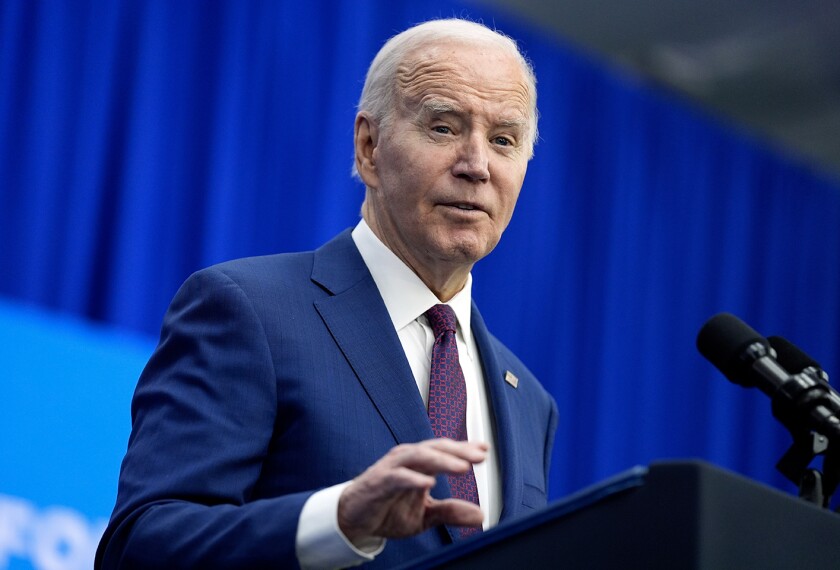Clarification: This article has been revised to clarify that the U.S. Department of Education will prioritize school construction projects when considering applications to extend ESSER spending deadlines for contract expenses. Other such applications would be considered only for extenuating circumstances.
Schools can seek more than a year’s worth of time to finish spending federal pandemic relief funds on contracts for construction, mental health, tutoring, and other third-party services, the U.S. Department of Education confirmed Tuesday.
Districts will be able to request an additional 14 months beyond the previously understood deadline for spending some of the $200 billion K-12 schools got in three rounds of federal pandemic relief aid, according to the timeline laid out in a May 13 letter the department sent last Friday to AASA, the School Superintendents Association.
A department spokesperson stressed to Education Week on Tuesday that the agency typically grants deadline extensions for extenuating circumstances only, such as the supply chain issues that are delaying school construction projects, which will be given priority. Under existing regulations, however, schools could apply to extend the deadline for other types of contracts as well, the spokesman said.
The May 13 letter was responding specifically to school district advocates who were seeking more time to spend relief funds on infrastructure projects. Numerous media outlets and advocacy groups had reported since Friday that the extension opportunity would only apply to construction contracts, and only for the third round of federal aid, known as ESSER III. In fact, districts could apply to extend the spending deadline for all contracts and for all three rounds of aid, the department spokesperson said Tuesday.
Schools have until this September to “obligate” funds, or commit them to specific purposes, from the first round of federal COVID relief, known as ESSER I. The deadline to commit the second round of funds, ESSER II, is September 2023, and for ESSER III is September 2024.
Previously, schools were under the impression they would have four months from those deadline dates to “liquidate,” or spend, the funds. The Education Department’s May 13 clarification on that timeline cites obscure federal regulations that had gone overlooked by most district leaders.
Districts still have to obligate ESSER I funds by Sept. 2022, ESSER II funds by Sept. 2023, and ESSER III funds by Sept. 2024. But if they hire a contractor before the deadline, they can get 18 months past those dates instead of four to pay the contractor—if their state education department secures a waiver from the U.S. Department of Education on their behalf, Roberto Rodríguez, the department’s assistant secretary of planning, evaluation, and policy development, wrote on Friday to AASA.
Worries about money running out before work is done
School district leaders and their advocacy groups have been sounding the alarm for months that they might not be able to finish vital construction projects like repairing a roof or replacing an HVAC system before the federal support that made them possible runs out.
Soaring materials costs and persistent supply shortages have led many districts to shrink investments in facilities or wait to get started until market conditions improve.
A coalition of school and health advocacy groups sent a letter in January asking the department for more flexibility. With Friday’s response and Tuesday’s clarification, they got it—and more.
“The Department does understand the need for schools to address urgent and pressing projects, including school infrastructure projects, intended to safeguard the health and safety of students, educators, and staff during this pandemic,” reads the May 13 letter from Rodríguez.
District advocates cheered the news.
“These kids’ needs are not going to be gone starting in the ‘24-'25 school year,” said Sasha Pudelski, director of advocacy for AASA. Districts “might make decisions about how they’re going to shift their dollars around if they know they’re going to be able to extend these professionals for more than two years.”
The department said it will later share details for how school districts can request to extend the spending timeline, and how it will consider applications from state education departments.
Lee Ann Wetzel, superintendent of the Ridley district in suburban Philadelphia, might be among the applicants for a deadline extension. She’s been collaborating with a facilities team on a $3 million project to quickly replace a failing HVAC system in the district’s 20-year-old high-school building.
“The new building does not hold up like the 100-year-old building in my district,” Wetzel said. One section of its HVAC system in particular is “on its last legs.”
The geothermal building has some tricky specifications that will take time for construction crews to work through. Wetzel is hopeful that the project can wrap up by September 2024, but if it doesn’t, “the extension gives us a little bit of relief that we should be good” to finish paying the contractor after the obligation deadline, she said.
Some critics of schools’ pandemic recovery efforts might balk at giving schools more time. The department is still urging districts to spend ESSER funds as quickly as possible.
Schools have also signed contracts with third-party providers to spend ESSER funds on tutoring, mental health support, curriculum materials, professional development, technology tools, and even substitute teachers.
Pudelski anticipates many districts who have developed good relationships with third-party mental health providers will make the case for keeping them on using ESSER dollars past their originally planned deadline.
The clarified guidance “could be a very big game-changer,” she said.






